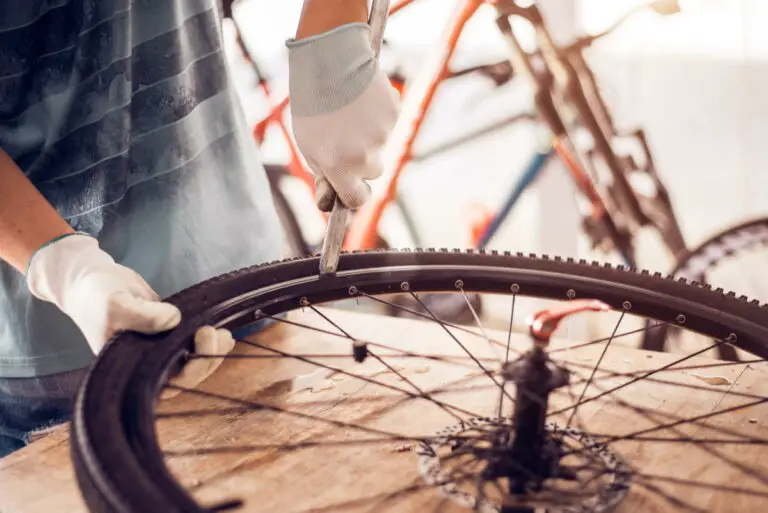What Are Tubeless Bike Tires?
Tubeless tires are a type of tire that doesn’t require an inner tube and instead uses a special sealant and a tight fit to seal the tire onto the rim and hold air in place. Since they don’t employ an inner tube, which has historically been the method used to secure tires to the rim of the wheel, they are known as “tubeless” tires.
Tubeless tires have the capacity to operate at lower air pressures, provide a smoother and more comfortable ride, and improve grip, among other advantages. The difficulty of installation and setup as well as the potential for more cuts and punctures in comparison to conventional tires with inner tubes are potential disadvantages to keep in mind.
Benefits of Tubeless Tires
The ability to operate at lower air pressures without running the risk of pinch flats is one of the key advantages of tubeless tires. When the inner tube becomes trapped between the tire and the wheel rim, a flat tire results. Tubeless tires are far less prone to pinch flats because they don’t have an inner tube.
Tubeless tires not only allow for lower air pressures but also provide a smoother and more comfortable ride. A smoother ride is produced because there is less friction between the tire and the road as there is no inner tube. Additionally, tubeless tires can be operated at lower pressures, expanding the contact patch of the tire with the ground and enhancing traction.
A further advantage of tubeless tires is enhanced traction. Particularly on difficult or uneven terrain, the absence of an inner tube and the ability to operate at lower air pressures might aid to extend the tire’s contact patch with the ground and enhance grip and handling.
Potential Drawbacks of Tubeless Tires
The complexity of installation and setup while using tubeless tires is one of the biggest potential disadvantages. The operation can be messy and can require some practice to get the sealant and tire placed correctly on the rim. However, setting up tubeless tires is typically not too difficult with a little perseverance and practice.
The possibility that tubeless tires may be more prone to cuts and punctures than conventional tires with inner tubes is another possible disadvantage.
This is due to the fact that an inner tube is more successful at plugging minor holes than the sealant used in tubeless tires at plugging larger cuts or punctures. A tire plug kit, which consists of a small piece of rubber that is placed into the hole to seal it, can still be used to repair tubeless tires.
Tubeless Tires for Off-Road Riding
Due to their capacity to operate at lower air pressures and enhanced traction on challenging terrain, tubeless tires are particularly well-liked for off-road riding, such as mountain biking. For off-road riding, tubeless tires have a number of advantages, such as:
- Lower air pressure: As was already noted, one of the key advantages of tubeless tires is that lower air pressures can be used without the danger of pinch flats. This is especially helpful while riding off-road because the terrain might be difficult and uneven. To boost grip, which is necessary for negotiating obstacles and trails, lower air pressures might help the tire’s contact patch with the ground.
- Improved traction: Tubeless tires are able to operate at lower air pressures and also provide better traction on off-road surfaces. Without an inner tube, there is less friction between the tire and the ground, which may enhance handling and grip.
- Enhanced ride quality: A further advantage of tubeless tires for off-road riding is their improved ride quality. It is possible to run at lower air pressures and absorb stress and vibrations from the terrain, making for a smoother and more comfortable ride because there is no inner tube.
- Easier to repair: Compared to a conventional tire with an inner tube, a tubeless tire is typically less difficult to fix if it does get punctured or cut. You may quickly and easily cover the hole with a tire plug kit, allowing you to resume your trail ride without changing the tire or inner tube.
While using tubeless tires for off-road riding has a number of advantages, it’s vital to keep in mind that some types of terrain may not be appropriate for them. For instance, tubeless tires may be more prone to punctures and cuts than conventional tires with inner tubes if you routinely ride on terrain with a lot of dirt or sharp items. Traditional tires with inner tubes might be a better option for you in this situation.
Tubeless Tires for Road Bikes
Off-road riding is not the only application for tubeless tires. The usage of them on road bikes is also growing in popularity. For road bicycles, tubeless tires provide the following advantages:
- Less rolling resistance: Compared to conventional tires with inner tubes, tubeless tires typically have less rolling resistance because there is no inner tube to contribute friction. This may lead to a quicker and more effective ride.
- Improved ride quality: Similar to off-road riding, the absence of an inner tube and the ability to operate at lower air pressures can aid to dampen shock and vibrations from the road, making the ride more comfortable and smooth.
- Better puncture resistance: Tubeless tires can nevertheless provide better puncture resistance even if they might be more prone to cuts and punctures than conventional tires with inner tubes. This is so that the tire won’t go flat, as the sealant used in tubeless tires helps to seal tiny holes and cuts.
As with off-road riding, the main potential drawback of using tubeless tires on a road bike is the difficulty of installation and setup. It can take some practice to get the sealant and tire seated properly on the rim, and the process can be messy. However, with some patience and practice, it is generally not too difficult to set up tubeless tires for road biking.
Tubeless Tires vs. Traditional Tires
What are the primary distinctions between regular tires with inner tubes and tubeless tires, then? Here is a brief contrast:
- Air pressure: While standard tires with inner tubes may need higher air pressures to prevent pinch flats, tubeless tires can be operated at lower air pressures without running the danger of pinch flats.
- Ride quality: Since tubeless tires don’t require an inner tube and may operate at lower air pressures, they typically provide a smoother and more comfortable ride. Due to the inner tube’s presence and the requirement for higher air pressures, traditional tires with inner tubes may provide a significantly rougher ride.
- Traction: Due to the lack of an inner tube and the ability to operate at lower air pressures, tubeless tires may provide better traction. Due to the inner tube’s presence and the requirement for greater air pressures, traditional tires with inner tubes may provide slightly less traction.
- Puncture resistance: Compared to conventional tires with inner tubes, tubeless tires may be more prone to cuts and punctures, but they can still provide greater puncture resistance because of the sealant used in the tire. Due to the inner tube’s existence, conventional tires may be more prone to punctures, although they can usually be repaired more quickly by changing the inner tube.
Due to the advantages they provide, tubeless tires are a preferred option for many cyclists. They can offer a more comfortable and smoother ride, better grip, and the capacity to operate at lower air pressures. It’s crucial to keep in mind that they might not be appropriate for all sorts of riding and might require more setup and maintenance than conventional tires with inner tubes.
It’s important to balance the benefits and drawbacks.


